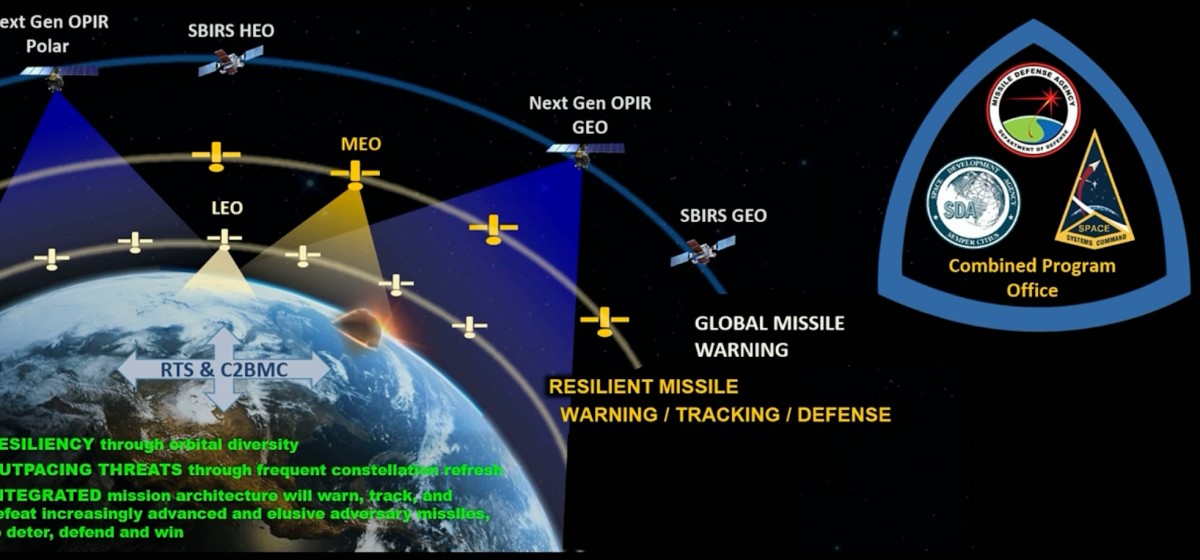The U.S. Department of Defense has reopened the debate on space‑based missile defence with a formal request for information (RFI) on Space‑Based Interceptors (SBI), pointing to a migration from siloed, terrestrial shooters to a distributed orbital layer. The centre of gravity is architectural: whether a proliferated constellation can cut engagement timelines, harden the overall kill chain against attack, and complicate an adversary’s strike calculus across the boost and midcourse phases.
Key Facts
- Public signal. On 27 June 2025, the U.S. Missile Defense Agency (MDA) posted an RFI seeking industry inputs on architectures and enabling technologies for a proliferated SBI constellation, including guidance, communications, autonomy and survivability under contested conditions [1].
- Preceding industry days. The RFI followed April–May 2025 industry engagement notices hosted with U.S. Space Force, indicating an early yet structured market‑survey phase [2].
- Cost realism enters the chat. In May 2025, the U.S. Congressional Budget Office refreshed the cost picture for SBI concepts, noting constellation costs scale roughly with attack size and positioning constraints [3].
- Beyond niche press. Coverage remains sparse in mainstream defence media, even as follow‑on notices hint at prototype solicitations and broader “Golden Dome” initiatives [4][5].
Why this matters now
Missile defence has historically stacked ground‑based (GBI/NGI), sea‑based (Aegis/SM‑3), and limited air‑borne layers. These provide proven but geographically and temporally constrained coverage, especially for boost‑phase intercept where the engagement window is measured in minutes. A space‑based missile defence layer promises persistent custody and geometry advantages—interceptors already positioned on orbit, potentially reducing launch latency and diluting single‑point vulnerabilities on land or at sea.
That promise comes wrapped in hard questions: constellation size, orbital planes, sensor‑to‑shooter latency, weaponisation politics, and industrial affordability. The June RFI brings those trade‑offs into the formal acquisition conversation—less a program of record, more a requirements‑shaping exercise.
What the RFI actually asks
The MDA notice is explicit on scope: catalogue existing or near‑term technologies and outline conceptual architectures for a proliferated SBI layer. The request ranges beyond the kill vehicle to the full stack—command and control (C2), crosslink communications, guidance and GNC (guidance–navigation–control), autonomy, sensors and survivability in a contested space environment [1]. There is no immediate procurement commitment; rather, the agency is collecting data to inform alternatives analysis and future solicitations.
Meanwhile, Space Force notices point to a division of labour: Space Systems Command leaning into space‑segment prototyping while MDA evaluates intercept‑weapon integration and engagement logic [2][4]. Together, the breadcrumbs suggest an FY2026–FY2027 window for concept studies and early technology demonstrations.
Technical and operational realities
Orbital mechanics and positioning. An SBI constellation must put interceptors where trajectories will be—not where they are now. That implies multiple orbital planes, carefully chosen altitudes (LEO for timelines vs. MEO for coverage), and a replenishment model for atmospheric drag, station‑keeping, and attrition. Even with good coverage, kinematic geometry won’t always cooperate; some launches will out‑pace the nearest shooter.
Sensor fusion and custody. Interceptors can carry onboard seekers, but practical concepts rely on external cueing from ground radars and space sensors (e.g., HBTSS‑like tracking layers). The data path must sustain low‑latency track custody and handover to the interceptor’s onboard guidance, with resilience against jamming or spoofing.
Weapons integration in small buses. Packing a kill vehicle, divert thrusters, power, thermal control, and hardened electronics into small‑satellite form factors stretches mass and volume budgets. Designers face unkind trades between divert delta‑V (for endgame manoeuvre), propellant fraction, and on‑orbit lifetime.
Resilience by proliferation. A dense constellation raises the bar for an adversary’s counterspace campaign—more targets to hunt, more redundancy in the kill chain. Yet distributed doesn’t mean invulnerable: ASAT threats, co‑orbital stalkers, uplink/downlink jamming, and cyber intrusion all remain.
Command responsibility and ROE. Intercepting from space is not just engineering; it is policy. Clear rules of engagement (ROE), positive human control over weapons release, and allied coordination mechanisms will be mandatory to avoid accidental escalation or fratricide.
“Constellation sizing is not a beauty contest; it’s a geometry and cost problem. Every added plane buys you coverage and resiliency—until launch mass, replenishment cadence, and integration manpower push you over budget.”
The money problem (and why launch cost matters)
CBO’s 2025 analysis reframed affordability: SBI cost scales with attack size and desired assurance. Lower launch costs help, but they don’t make physics free [3]. Three levers dominate the bill:
- Constellation design (number of satellites, planes, altitudes) → drives initial deployment tonnage.
- On‑orbit lifetime and replenishment → sets the annual sustainment tonnage and cadence.
- Interceptor performance (divert capability, seeker sophistication) → trades mass for effectiveness.
Commercial rideshare and standardised buses could compress unit costs, but weapons‑grade hardening and certification are not cube‑sat economics. The acquisition path must keep the offense/defense cost ratio in check or the business case collapses.
Alternatives, complements, and competition for dollars
Boost‑phase from air or stratosphere. High‑altitude aircraft or balloons carrying directed energy or hit‑to‑kill interceptors promise responsiveness without orbital baggage. Maturity remains uneven, but some concepts could undercut SBI cost per shot.
Midcourse hardening. Better discrimination (decoy rejection), networked fire control, and low‑cost exo‑atmospheric interceptors might offer cheaper marginal coverage where SBI is weakest.
Under‑layer and terminal systems. Recent MDA notices point to an under‑layer concept and terminal intercept improvements—these can absorb near‑term funds while SBI matures [5]. In tight budgets, portfolios compete.
NATO and allied implications
Allies will watch two channels. First, industrial participation—bus manufacturing, seekers, divert propulsion, on‑orbit servicing—where European and Asia‑Pacific firms are credible suppliers. Second, policy alignment: the Alliance will need shared positions on weapons in space, tasking authority, and command relationships if SBI is to backstop collective defence.
For Türkiye’s ecosystem—represented by SAHA İstanbul’s deep supplier base—radiation‑hardened electronics, autonomy, C2/mission‑data management, optical inter‑sat links, and precision thruster modules are natural niches. The SBI conversation is not merely an American procurement story; it is a potential supply‑chain reshuffle across NATO’s defence‑tech map.
What to watch next
- Follow‑on BAAs/RFPs for prototype interceptor buses, seekers, and autonomy stacks in FY2026–FY2027.
- Space‑to‑space test campaigns—captive‑carry or subscale end‑game demos to validate guidance and divert logic.
- C2 and safety cases—formal ROE and human‑in‑the‑loop control frameworks that pass legal/policy muster.
- Allied policy notes—NATO debates on space rules and participation frameworks.
Internal links
- Analysis hub: Defence Agenda — Strategic & missile defence analysis
- News hub: Defence Agenda — Space & orbital congestion news
References
[1] SAM.gov — “Missile Defense Space Based Interceptors (SBI) — Request for Information,” posted 27 June 2025. Link
[2] SAM.gov — “Industry Engagement for Space‑Based Interceptor (SBI),” Apr–May 2025 notices. Link
[3] U.S. Congressional Budget Office — “Effects of Lower Launch Costs on Previous Estimates for Space‑Based Interceptors,” 5 May 2025. PDF
[4] Aviation Week — “Space Force to Issue Space‑Based Interceptor RFP on Sept. 5,” 22 Aug 2025. Link
[5] GovConWire — “MDA Issues RFP for $151B SHIELD Contract,” 12 Sep 2025. Link
Further Reading
- Arms Control Association — “Questions to Ask About Proposals for U.S. Space‑Based Missile Interceptors,” 10 June 2025. Link
- CBO — “Effects of Lower Launch Costs on Previous Estimates for Space‑Based Interceptors,” 5 May 2025. PDF
- SAM.gov — “Industry Engagement for Space‑Based Interceptor (SBI),” Apr–May 2025 notices. Link











